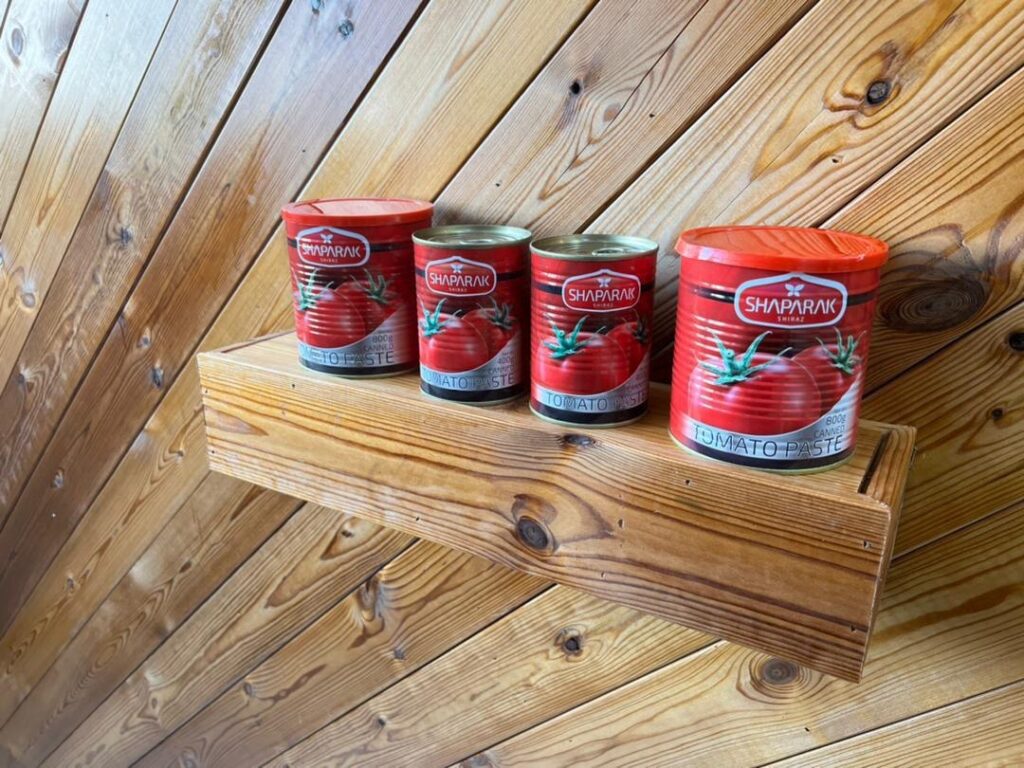
Shaparak tomato paste is one of the most popular brands of tomato paste in Iran, known for its high quality and rich flavor. This article explores the features, production process, and benefits of using tomato paste in cooking.
Contact us to find out about the status of prices and inventory information, as well as the conditions for selling, exporting, and importing this product in different places.
mehdi sharifi // +989171506174 /// info@ariakala.com
Production and Quality Standards

Shaparak tomato paste is produced using the latest technology under the supervision of food experts. The production process ensures that the vitamins and nutrients in tomatoes are well-preserved, resulting in a product rich in antioxidants, particularly lycopene. This paste also adheres to international standards such as ISO and HACCP, guaranteeing its health and hygiene.
Unique Features
With its high concentration and natural red color, tomato paste not only enhances the beauty of dishes but also improves their taste and aroma. These characteristics have made Shaparak a favorite brand among Iranian families and restaurants.
Culinary Uses
Due to its suitable consistency and excellent taste, Shaparak tomato paste is used in a variety of Iranian and international dishes. It is ideal for preparing different stews, sauces, pizzas, and pastas and can also be used as a dressing in salads.
Shopping Tips and Storage
When purchasing tomato paste, ensure the product has intact packaging and an appropriate expiration date. For longer preservation, store the paste in a sealed container in the refrigerator to prevent flavor and color changes.
Shaparak Tomato Paste : An Optimal Choice for Every Kitchen
Shaparak tomato paste is not only recognized for its high quality and pleasant taste but also for its use of up-to-date technology and adherence to sanitary standards. This article provides a thorough review of its characteristics, production processes, and the advantages of using this product.
Quality Assurance with International Standards
tomato paste is produced from the finest tomatoes and advanced technology. It maintains full compliance with ISO and HACCP standards, enhancing consumer trust due to its guaranteed quality and hygiene.
Rich in Antioxidants
One of the most prominent features of Shaparak tomato paste is its richness in antioxidants, especially lycopene. As a result, this nutrient helps improve heart health and reduces the risk of many diseases, making its consumption highly recommended in diets.
Culinary Applications
Shaparak tomato paste’s high concentration and quality make it a versatile ingredient in both traditional and modern cuisines. It not only enhances the flavor of foods but also contributes to their visual appeal, which is crucial for any culinary endeavor.
Tips for Buying and Storing
When buying tomato paste, check that the product has a recent production date and secure packaging. To maintain freshness longer after opening, store the paste in a sealed container in the refrigerator to avoid spoilage and taste alteration.
With its superior quality and nutritional benefits, Shaparak tomato paste is an ideal choice for any kitchen, elevating the taste and healthiness of various dishes.
How is Shaparak Tomato Paste Made?
- Shaparak is produced from high-quality, fresh tomatoes that undergo a rigorous process of selection, washing, and crushing. These tomatoes are then cooked to achieve the perfect consistency and flavor. Furthermore, the production takes place in hygienic environments under strict quality control to ensure the best product.
Why Choose Shaparak for Cooking?
-
- Shaparak Tomato Paste is renowned for its rich flavor and thick consistency, making it ideal for enhancing the taste and appearance of various dishes. Therefore, it’s a favorite in both home kitchens and professional settings due to its ability to improve both traditional Iranian and international cuisines.
How Should I Store Tomato Paste?
-
- To ensure Shaparak Tomato Paste maintains its freshness and flavor after opening, store it in a sealed container in the refrigerator. Always check the expiration date when purchasing to guarantee you are getting the freshest product.

